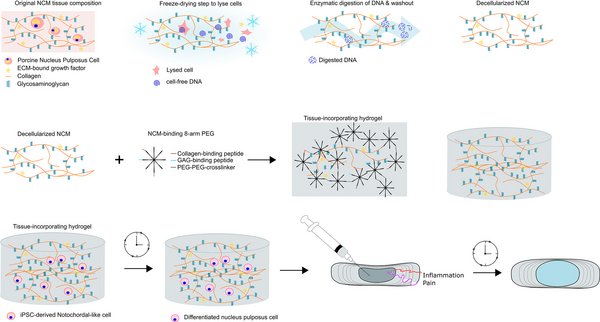
Intervertebral discs (IVDs) are an essential component of the functioning spine in vertebrates. They provide resistance to axial compression and allow for a range of motion of the spine itself. IVDs consist of two substructures, namely the annulus fibrosus (AF) comprising the outer part of the disc, and the nucleus pulposus (NP) within the center.
Prior to adolescence, notochordal cells (NCs) can still be found in the human NP, which are thought to maintain the proliferative and maintenance capabilities of the cells in the NP. After ca. 10 years, these mesenchyme-derived progenitor cells however mostly disappear, and the inherent regenerative capacity of the IVD is greatly diminished. Degenerative disc disease (DDD) slowly sets in, often culminating in lower back pain in adults many years later.
NCs are thought to secrete a distinct set of soluble stimulating factors leading to increased ECM production by nucleus pulposus cells. Using the notochordal-cell derived nucleus pulposus matrix (NCM) of porcine origin as a biomaterial thus presents an intriguing opportunity, as it contains the secreted factors excreted by the NCs. Two possible immunogenic artefacts within the NCM are remnant α-galactose (a carbohydrate epitope not found within primates), and extracellular DNA containing porcine endogenous retroviruses. Prior to utilization in a clinical setting, NCM is therefore subjected to a decellularization process removing these components.
To establish the required mechanical properties of the tissue (mimicking the properties of human NP tissue), further mixing of the processed NCM is required. To this end, a peptidePEG-hydrogel will be used to selectively bind to NCM structural components, while leaving the growth factors accessible to the cells.